|
|
|
Sort Order |
|
|
|
Items / Page
|
|
|
|
|
|
|
| Srl | Item |
| 1 |
ID:
166820
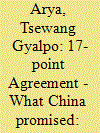

|
|
|
|
|
| Summary/Abstract |
From the historical perspective, despite the China’s claim that Tibet has been a part of China since ancient time1, irrefutable facts abound to demonstrate that Tibet has never been a part of China anywhere in its pre-1949 history2. It is only after the formation of People’s Republic of China (PRC), that China began to assert sovereignty over Tibet. The Communist China has tried to claim Tibet as a part of China under various unsubstantiated grounds. But like most of its concocted propaganda, the nature of their claims kept changing. First, they claimed Tibet as a part of China since 7th century Tibetan Emperor Srongtsan Gampo [Tib: Srong btsan sgampo], when the Tang Princess Wencheng Kungchu became one of the queens of Tibet.
|
|
|
|
|
|
|
|
|
|
|
|
|
|
|
|
| 2 |
ID:
135540
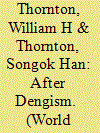

|
|
|
|
|
| Summary/Abstract |
The seeming departure of president Xi Jinping from Deng Xiaoping’s “pragmatic” moderation owes much to a highly tendentious misrepresentation of Deng’s core objectives. For 35 years, Dengism has been viewed through a globalist lens that flatly contrasts it with Maoist authoritarianism. From a post globalist vantage however, it appears that Deng’s reforms reconfigured rather than ended statist oppression. dengism was born out of the recognition that capitalism and authoritarianism were fully compatible and together were crucial for the survival of the CCP. “Opening China” China was Deng’s ironic mechanism for safeguarding against claims, which mandate a liberal corrective that Xi fears more than any other international contest. What he and other CCP elites dread most is a liberal post-globalisation that could foment a grassroots “China Spring”.
|
|
|
|
|
|
|
|
|
|
|
|
|
|
|
|
| 3 |
ID:
141515
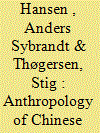

|
|
|
|
|
| Summary/Abstract |
The contemporary world is experiencing massive transnational population movements under the banner of higher education. This is in no small part due to the People’s Republic of China (PRC). Beginning in the late 1970s, PRC policies have actively encouraged young Chinese to go abroad to study as part of their higher education. Since then, the state has increasingly relinquished control over educational migration, turning instead to creating incentives for academic “talents” in key fields to either return to China or serve Chinese interests while living abroad (Liu 2014; Xiang and Shen 2009; Zweig, Fung, and Han 2008). Concurrent with this political relaxation, average Chinese incomes have risen dramatically, and higher education has grown gradually more integrated at a global level. The result has been remarkable. For some years now, China has been the largest global source of transnational students.
|
|
|
|
|
|
|
|
|
|
|
|
|
|
|
|
| 4 |
ID:
114898
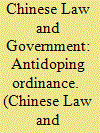

|
|
|
| 5 |
ID:
158740
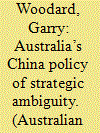

|
|
|
|
|
| Summary/Abstract |
History, little understood, shows that for 55 years a policy of ‘strategic ambiguity’ about the application of the Australia, New Zealand, United States Security Treaty to Taiwan, a flashpoint in Asia, served Australia well. Return to it could lessen the risks of embroilment in any Sino-American war in East Asia, and enhance Australia’s middle-power options.
|
|
|
|
|
|
|
|
|
|
|
|
|
|
|
|
| 6 |
ID:
146099
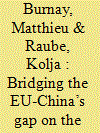

|
|
|
|
|
| Summary/Abstract |
As the European Union (EU) and the People’s Republic of China (PRC) celebrate 40 years of bilateral relations, the partnership continues to develop inter alia with the launch of a new Legal Affairs Dialogue, announced during the 17th EU-China summit (June 2015). As Rule of Law approaches greatly differ between the PRC and the EU and contain unbridgeable conceptual gaps, the new Legal Affairs Dialogue might further contribute to changes in the EU’s strategy of external Rule of Law, faced with the PRC’s own narrative and approach to the Rule of Law. On the other hand, the new dialogue might offer room for agreement and convergence on various global, bilateral and domestic levels. Recent domestic adjustments in the PRC and a manifest interest in reforming its legal system at a time when the EU is itself re-thinking its strategy of external rule of law offers a great potential for significant exchanges and an opportunity to bridge the Rule of Law gap between the PRC and the EU.
|
|
|
|
|
|
|
|
|
|
|
|
|
|
|
|
| 7 |
ID:
151365
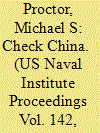

|
|
|
|
|
| Summary/Abstract |
The People’s Republic of China (PRC) recently suffered a serious embarrassment in front of an international arbitral tribunal convened under authority of the U.N. Convention on the Law of the Sea (UNCLOS). The Permanent Court of Arbitration dismissed decades-old PRC claims to sovereignty over a large swath of the South China Sea. The PRC, however, rejected the tribunal’s decision and appears ready to carry out some sort of escalation to demonstrate that it maintains sovereignty.
|
|
|
|
|
|
|
|
|
|
|
|
|
|
|
|
| 8 |
ID:
146372
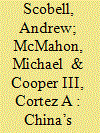

|
|
|
|
|
| Summary/Abstract |
One of the most eye-catching episodes in China’s defense buildup was the 25 September 2012 commissioning of Beijing’s first aircraft carrier. The sixtyfive-thousand-ton Liaoning was launched with much fanfare, presided over by the president of the People’s Republic of China (PRC), then Hu Jintao, as well as by the vice president and Hu’s political successor, Xi Jinping. The commissioning of Liaoning underscored both the remarkable advances in the PRC’s shipbuilding in recent decades and the significant limitations that remain. The vessel immediately became the largest in the People’s Liberation Army Navy (PLAN).
|
|
|
|
|
|
|
|
|
|
|
|
|
|
|
|
| 9 |
ID:
139827
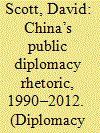

|
|
|
|
|
| Summary/Abstract |
During Hu Jintao’s period of leadership, careful public diplomacy language was deployed by the People’s Republic of China from 2000–2012 to describe the international system and China’s role within it. The terms looked at in this analysis are those introduced in the 2000s to recalibrate the ‘multi-polarity’ [shijie duojihua] emphasis of the 1990s. These terms have been deployed within a general ‘reassurance diplomacy’ that emphasised concepts like ‘responsible Great Power’ [fuzeren da guo], ‘multi-lateralism’ [duobian zhuyi], ‘good neighbourhood policy’ [mulin zhengce], ‘democratisation of international relations’ [guoji guanxi mingzhuhua], ‘peaceful rise’ [heping jueqi], ‘peaceful development’ [heping fazhan] and ‘harmonious world’ [hexie shijie]. Ambiguities, implications, impact, and tensions surrounding these terms are considered, and China’s deliberate adjustments pinpointed. China’s soft power intentions emerge from its instrumentalist use of diplomatic rhetoric, though a credibility gap also emerged between actions and words by 2012.
|
|
|
|
|
|
|
|
|
|
|
|
|
|
|
|
| 10 |
ID:
134441
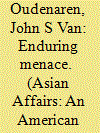

|
|
|
|
|
| Summary/Abstract |
Since the 1980s, Hong Kong triad societies have evolved from hierarchical, pyramidal organizations to loose, compartmentalized syndicates that retain a modicum of hierarchy. Changes in triad organization and modus operandi occurred in response to stringent anti-organized crime measures enacted in Hong Kong. However, organizational evolution has facilitated triad transplantation to China and improved triads’ ability to engage in transnational crime. Triads have exploited favorable circumstances in China: prevalent corruption, rapid urbanization, and high demand for illicit goods and services. This paper includes two case studies of the Sun Yee On triad. The first examines Sun Yee On's localized activity by tracing the evolution of one Shenzhen area chapter. The second case study examines Sun Yee On's role as a supplier of methamphetamine precursor chemicals to Mexico's Sinaloa cartel. Sun Yee On exemplifies how modern triads have become hybridized, assuming attributes of both local Chinese organized crime and transnational criminal networks.
|
|
|
|
|
|
|
|
|
|
|
|
|
|
|
|
| 11 |
ID:
170666
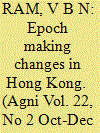

|
|
|
|
|
| Summary/Abstract |
A
chronological synopsis relating to the epoch-making changes
in Hong Kong would be landmarked thus:
The People’s Republic of China (PRC) came into being in 1949. As
noticed often in the past, PRC as a matter of policy refuses to accord
recognition to accords/compacts signed by regimes preceding its
formation, even though such agreements may have been consented
to by areas now within PRC. PRC’s refusal to recognize the McMahon
Line as India’s border with the Tibet Autonomous Region of PRC, is
just one example, amongst many others.
|
|
|
|
|
|
|
|
|
|
|
|
|
|
|
|
| 12 |
ID:
163441
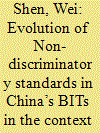

|
|
|
|
|
| Summary/Abstract |
The European Union (EU) and the People’s Republic of China (PRC or China) in January 2014 decided to launch negotiations on a bilateral treaty addressing the promotion and protection of investment between the two parties. This article mainly examines the legal positions from which the parties will proceed their negotiations in terms of the non-discriminatory standards, that is, the national treatment and the most-favored-nation treatment, which are said to be the cornerstone of foreign investment protection, by focusing on the evolution of non-discriminatory standards in China’s BITs against the same standards in the EU BITs, in particular, the EU’s recently concluded three important treaties regulating, among other things, foreign investment, namely with Canada, Singapore and Vietnam. Domestically, the reference value of BITs signed by China in the 1980s and 1990s has been significantly affected by the dynamic economic reform and market development in the past four decades. Essentially, globalisation has fundamentally lifted China’s foreign investment standards up to international standards. As a result, while the market anticipates the difficulties in the ongoing negotiations, the gap between the EU and China, as argued in this article, should be noticeably slight when the EU and China come to negotiate the non-discriminatory standards.
|
|
|
|
|
|
|
|
|
|
|
|
|
|
|
|
| 13 |
ID:
163765
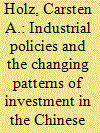

|
|
|
|
|
| Summary/Abstract |
Investment has always played an important role in the economic development strategies of the People’s Republic of China. A major reform of the investment system in 2004 shifted the state’s focus from direct investment control to industrial policies designed to promote investment in specific economic sectors. But in reality, the industrial policies’ preferences have had little effect. The data suggest that investment patterns in China are largely divorced from the industrial policies, and, if anything, predate them. The significant shifts in investments across sectors and ownership forms that have taken place since the early 2000s appear driven far more by profitability considerations and private entrepreneurship than by government policies. The finding negates foreign concerns that the Chinese state via industrial policies such as “Made in China 2025” is creating national state-owned technological leaders.
|
|
|
|
|
|
|
|
|
|
|
|
|
|
|
|
| 14 |
ID:
147605
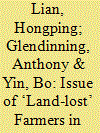

|
|
|
|
|
| Summary/Abstract |
Based on an empirical fieldwork study in a central-south municipal city in China, this article discusses the contestation between land-lost farmers and local government in the process of urbanization and land expropriation, focusing on the land-lost farmers’ responses to this process. After a discussion of land-lost farmers’ reasons for discontent and their actions, it is argued that such a contestation is an interaction where land-lost farmers tend to lay claim to their legitimate morality while local government lays claim to its legitimate authority, through the institutional approach of an appeal system provided by the state. The truth is that not only do both sides of the contestation have to rely on the power conferred by the central state, but also they constitute an interdependent local network.
|
|
|
|
|
|
|
|
|
|
|
|
|
|
|
|
| 15 |
ID:
174802
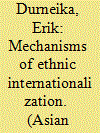

|
|
|
|
|
| Summary/Abstract |
This article – by looking at selected cases of the ethnic Tibetans, Uyghurs, and Mongols in the People’s Republic of China (PRC), officially a unitary multinational state – proves that domestic ethnic conflicts have the potential to internationalize and become significant interstate crises. While internationalization factors may at times be difficult to differentiate, I highlight four main mechanisms: 1) third-party intervention, 2) irredentism/separatism, 3) refugee movements across borders, and 4) international ethno-terrorism. Media coverage of ethnic conflict may also initiate a call for justice from the international community. The PRC remains a special case, with the Chinese Communist Party’s continued control over ethnic policy and interactions. This research article also reinforces the idea that ethnic conflict can be integrated into both comparative politics and international relations, as such domestic conflicts often involve and affect actors that transcend state boundaries.
|
|
|
|
|
|
|
|
|
|
|
|
|
|
|
|
| 16 |
ID:
163451
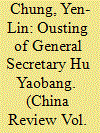

|
|
|
|
|
| Summary/Abstract |
With the support of Party elders led by Deng Xiaoping, Hu Yaobang
assumed the top position in the Chinese Communist Party (CCP). �is
article examines the roles played by the powerful “revolutionary elders”
in Hu’s dismissal from the post of CCP General Secretary in early
1987. Special attention is paid to the role of Peng Zhen. �is detailed
study furthers our understanding of the nature and operations of
Chinese elite politics in the Deng era, and of the complex generational
relations between the old revolutionaries and the successor generation
of leaders.
Deng Xiaoping (鄧小平), Chen Yun (陳雲), Peng Zhen (彭真), and others
among the post-Mao Party elders had been in�uential statesmen in the
People’s Republic of China (PRC) during the pre–Cultural Revolution
|
|
|
|
|
|
|
|
|
|
|
|
|
|
|
|
| 17 |
ID:
134439
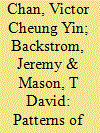

|
|
|
|
|
| Summary/Abstract |
Since the Tiananmen Square protests of 1989, there have been no national protest movements in the People's Republic of China (PRC). This is the longest period in the history of the PRC without a major national protest movement. Nonetheless, the number of small, local protests or “mass incidents” (as they are termed by the Chinese government) has increased from 9,000 a year in 1994 to over 180,000 in 2010. Most of these incidents target local party and government agencies and/or local firms. Protests by peasants are often motivated by land confiscation by local governments, while worker protests are often over firm treatment of works (including pay, benefits, and job security). More general protests arise over what participants perceive as unfair and illegal extractions of fines, fees, and other payments by local government and party units. We present a theoretical argument on how grievances and mobilization capacity affect the likelihood of protests occurring in a locale. We then test propositions derived from this theory with provincial level data for the period 1995–2010. This study represents one of the first to test predictors of the frequency of mass incidents at the province level.
|
|
|
|
|
|
|
|
|
|
|
|
|
|
|
|
| 18 |
ID:
139453
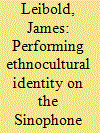

|
|
|
|
|
| Summary/Abstract |
This article explores what happens to the Chinese Party-state’s notion of minzu (nationality, ethnicity or ethno-national identity) in the vastness of cyberspace. The idea that the People’s Republic of China (PRC) comprises 56 distinct yet united minzu groups has encapsulated and circumscribed the performance of ethnocultural diversity in mainland China over the last 60 plus years. In this article, I seek to demonstrate how the Internet helps to loosen the Party-state’s grip on ‘Chineseness’ and its related categories of identity, opening up new spaces for the articulation of a wide range of ethnocultural subject positions that both self-define, mediate and, at times, even transcended minzu-ness. At the same time, however, the fractured and transitory nature of these online congregations renders them largely inconsequential when faced with a powerful and authoritarian Party-state and its robust regime of minzu classification and minzu-based policies inside the PRC.
|
|
|
|
|
|
|
|
|
|
|
|
|
|
|
|
| 19 |
ID:
149649
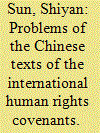

|
|
|
|
|
| Summary/Abstract |
This article re-examines the problems of the Chinese texts of the two International Covenants on Human Rights, which were raised 10 years ago and further dwelt upon by other scholars more recently. Each Covenant has a Chinese text that is different from the authentic Chinese text but has been prevailing in the United Nations human rights publications and in the People’s Republic of China. The appearance of the prevailing but invalid Chinese texts may well be attributed to the negligence of the United Nations in early 1970s. The People’s Republic of China has blindly trusted those United Nations publications and thus has always used the prevailing Chinese texts. Any inquiries of relevant matters must be done on an objective and impartial basis and in a logical and responsible way.
|
|
|
|
|
|
|
|
|
|
|
|
|
|
|
|
| 20 |
ID:
168376
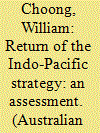

|
|
|
|
|
| Summary/Abstract |
Eleven years after it was abandoned, the so-called Indo-Pacific concept is back with a vengeance in regional security debates. At the 2017 Shangri-la Dialogue, there were only five mentions of the ‘Indo-Pacific’ at the annual defence ministerial forum. In the following year, the figure had jumped to 92. The Indo-Pacific Four countries promoting the ‘free and open Indo-Pacific’ (FOIP) concept share many principles, including freedom of navigation and overflight, connectivity and economic growth, and respect for the rule of law. There are, however, clear points of divergence between them, such that there are actually different Indo-Pacific strategies among the Indo-Pacific Four. Even if the Indo-Pacific Four manage to resolve these issues (and the possibility of this is low), it is not likely that ASEAN would endorse the FOIP concept. The reality remains that Indonesia and ASEAN have taken a different approach to the Indo-Pacific. The ASEAN approach is to appropriate elements of FOIP strategy which are more attractive to ASEAN (for example, connectivity and infrastructure), yet reject elements of FOIP strategy which ASEAN deems inappropriate (the exclusion of China and the loss of ASEAN centrality). This does not augur well for the adoption, in its entirety, of the FOIP concept by ASEAN.
|
|
|
|
|
|
|
|
|
|
|
|
|
|
|
|
|
|
|
|
|